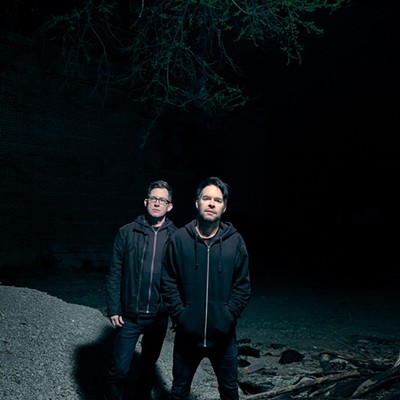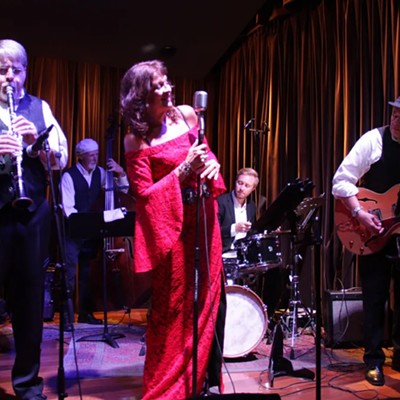It happened in 1976, when the music biz was just realizing how puffy the economics of rock and roll could actually be, that it didn't take a Woodstock-caliber roster of acts to fill stadiums, that Peter Frampton would sell out just fine on his own. As the cost-effective double live albums that would become a staple of the era were rolled out, the money started rolling in; though artists at least had a fighting chance of building a career on a then-major label, finally in rock music, which once sought to give a voice to youth, commerce trumped art. Rock and roll was big business, and big business always has its eye on the bottom line.
Meanwhile, a slew of bands that sought to bring inventiveness back to the music, at a time when it was severely lacking, sprang up in New York City, specifically at CBGB and OMFUG (Country Bluegrass Blues and Other Music for Uplifting Gourmandizers), a bar taken over by Hilly Kristal in 1973, with one caveat to its booking policy: original music only. With a headquarters of their own, bands such as the Ramones, Talking Heads, Television, and Blondie began playing regular slots, and punk rock first gained notoriety. It was, primarily, a local scene, albeit one so far-reaching as to change the course of rock's history--future members of the Sex Pistols and The Clash, which jump-started the British end of punk, were in attendance at the Ramones' first U.K. shows; last month, the Ramones and Talking Heads were inducted into the Rock and Roll Hall of Fame.
The scene was much the same in the early '90s, when the charts were dominated by cheese-metal bands who seemed more concerned with their hair, makeup, spandex, and which '70s tune to cover next, than they did exhibiting any sort of real artistic merit. Mainstream rock and roll had become pure showbiz, a peroxide-bleached cliché of excesses, pre-packaged rebellion that was neither dangerous nor rebellious. It had become mere product.
There was, however, a fairly healthy rock underground co-existing with the flatulence, albeit on a far more diminished scale. Bands like Sonic Youth, Dinosaur Jr., and the Pixies were eking out a living, mostly by releasing albums on independent labels and touring extensively. But quite simply, when Nirvana, previously just another indie rock band, released Nevermind, on Geffen, in 1991, the underground almost instantly became mainstream. Any band out of the Pacific Northwest, regardless of sound--really, could Nirvana, Pearl Jam, Soundgarden, and Mudhoney have sounded less like each other?-- was tagged "grunge," and grunge soon signified a way to market flannels and touques.
Enter, big-time corporate record labels, just in time to catch the inevitable jumping of the perceived gravy train. "Alternative" became the catch-word for any band either doing something somewhat inventive, or any band that copied such bands, as long as they didn't come from Seattle. When the majors signed any band that called itself such, the bottom fell out. The labels cut their losses by dropping any band that sold less than such-and-such right out of the box, and "artistic development" became a footnote from the pages of some era that might have once existed. Corporate buy-outs and mergers of labels, in the late '90s, only worsened the situation. And so, with fresh corporate dollars in their pockets, the labels' means had to justify the end: The investors must be pleased. Or, in music biz lingo, we need a hit, quick.
Draw your own line from the "A" in Aguilera to the "Z" in Bizkit, but keep in mind that teens and pre-teens don't have a whole lot to spend their allowances on besides CDs and videogames. And in the words of Lou Pearlman, impresario behind every boy band from New Kids to Backstreet Boys and *N Sync, "As long as there are teenage girls ... " So for the past several years, the choices for mainstream consumers in the pop/rock vein have largely been either come-hither-but-I'm-a-virgin pop tarts (and their boy "band"--none seem to play anything--counterparts, aimed at the same wallets) or the angsty, brooding but empty posturings of rap-injected nu-rock (and their counterparts, any band that has a singer that sounds like Eddie Vedder). It's easy to get the feeling that an A&R meeting at a post-merger major label would sound something like: "Kids, if it's got a belly ring, sign it. If it's got a tattoo, sign it. If it's got both, double the promo." In other words, something has been fiercely lacking in mainstream music lately, again.
All of which brings us to the fact that The White Stripes, a Detroit duo partially credited with a movement currently making waves in the corporate waters, are making their first Tucson appearance this week. Comprising singer/guitarist Jack White and drummer Meg White--brother/sister?; currently married?; formerly married?; Jack's dating Winona Ryder?; it all depends on who you ask, and when--the White Stripes are part of a resurgence of smart, stylish rock, being touted by all involved as the Next Big Thing.
The focus is squarely on New York City again, which currently boasts an abundance of diverse and unfettered, if stylish, and therefore slightly affected, pure rock bands like the Strokes, Moldy Peaches, French Kicks, the Walkmen, YeahYeahYeahs!, and !!!. And, in fact, it's arguable that the phenomenon would be limited to NYC if not for the Stripes themselves. Lest we forget that musical movements such as these are normally confined by geography, at least initially (punk = NYC; grunge = Seattle), the pure ferocity, simplicity and inventiveness, the sheer undeniablility, of The White Stripes have widened the movement's scope, and allowed bands such as the Von Bondies (also from Detroit) and the Hives (from Sweden) to be invited to the party.
On The White Stripes' three albums, released on Sympathy for the Record Industry (though the latest, White Blood Cells, was recently re-released on V2, a Virgin subsidiary), Jack segues from authentically sloppy Delta blues twang to Sabbath-meets-Buzzcocks-meets-Zep fret approximation, voice veering from Plant's white boy blues to scary Black Francis howls, pausing quietly, sensitively, to note, "I can tell that we are gonna be friends." Meanwhile, Meg exuberantly bashes away at the drums, simply, like Mo Tucker as a giddy kid, always nailing it right. The duo seems to inherently understand the proportions of garage rock, blues, punk, country, and pop hooks necessary to wring the maximum impact from their songs' arrangements.
Every movement needs a name. In the wake of catchy summations like "punk" and "grunge," "neo-garage" has been tossed around, as has "raw rock," credited to Neil Strauss, of The New York Times. But many wonder if it's all worth the bother, if it's all just label-perpetuated bluster, an attempt to corral a bunch of interesting but stylistically different bands into a tag-line, another angle on marketing schemes. Still, Courtney Love, who has no love for the labels with these bands in their sights, contended during an interview at this year's South By Southwest, that the neo-garage bands are "better than 'Teen Spirit,' way better."
While it's virtually inarguable that a fine new crop of bands is coming along at the right time, it remains to be seen whether, a decade from now, "new rock" will signify anything. Its commercial potential has yet to be determined, as well--though the Strokes' debut album, the biggest seller of the lot, just hit the 500,000 mark (gold), it's still a far cry from the multi-platinum numbers expected of major label players these days. For now, though, we can just be thankful that these bands have come along at a time when we need them, and that The White Stripes, arguably one of the best young bands on the planet right now, are playing in town this week.










